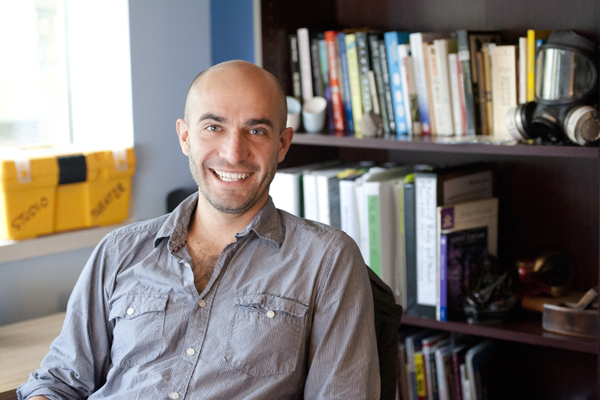A robotic revolution in theatre

Matthew Gray wants to give one of drama’s most famous lines a whole new meaning, without changing it at all.
“When a robot says, ‘What a piece of work is man,’ I think you get a completely different result than if a human actor is playing Hamlet,” said Gray, a new assistant professor of theatre in the College of Arts, Media and Design.
Before arriving at Northeastern this fall, Gray had already directed performances using robotic actors. With a cast of four reprogrammed Roombas — the automated vacuums that can navigate a room and avoid obstacles — Gray directed a performance of Samuel Beckett’s play “Quad,” a play that contains no dialogue and extremely complicated stage directions for the actors to follow, while working as a fellow at Carnegie Mellon’s STUDIO for Creative Inquiry, where he was a faculty member in the university’s School of Drama.
“We were interested to see if we could take the very detailed stage directions of a play and break them” into computer code, Gray said.
He now brings that experience — breaking down a performance into a series of specific instructions — into his acting classes at Northeastern. Often a director will give an actor some vague instruction that is less valuable than a much more direct instruction, the kind a robot might require to perform a task, Gray said.
Gray is working with friend and collaborator Heather Knight, who is completing her doctoral research at Carnegie Mellon’s Robotics Institute and running Marilyn Monrobot Labs in New York. The space creates socially intelligent robot performances and sensor-based electronic art. He plans to use her robot Data — named after the “Star Trek: The Next Generation” character, an android who strived to be more human — in a performance of Shakespeare monologues and scenes.
“We need to lose this illusion that an actor drives the performance,” Gray said. “It’s a collaboration, be it between an actor and a director or an actor and a programmer.”
Gray is also exploring innovative ways to advance the use of motion capture in theatre; for example, how devices like the Xbox Kinect — which converts a player’s motions into the actions of a computer avatar — could be used in stage, television, film or Internet performances.
Pointing to pioneering actors like Andy Serkis, who has used motion capture to play characters like Gollum in “Lord of the Rings,” Gray said that new, digital mediums are emerging that actors must learn to master.
“I think the revolution for theatre and technology will come from the person who says, ‘Here’s how you use technology in the things you already do all the time,’” Gray said.





